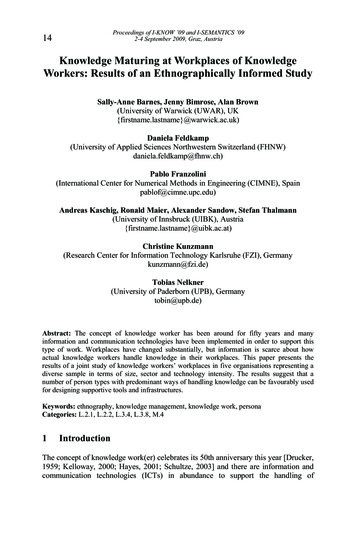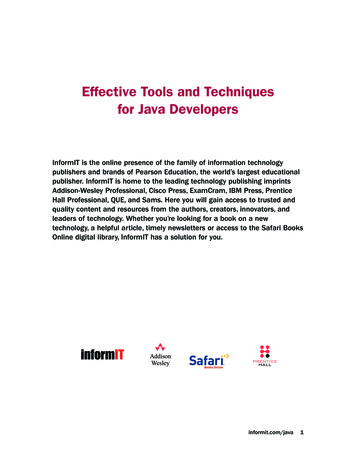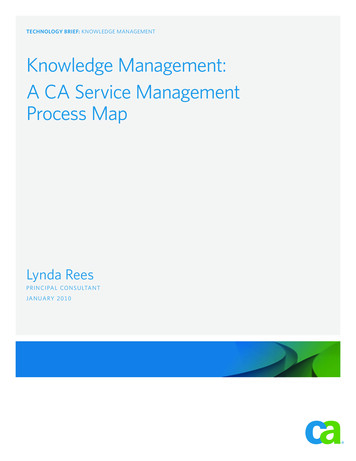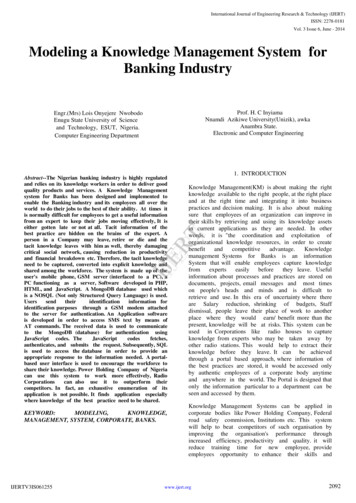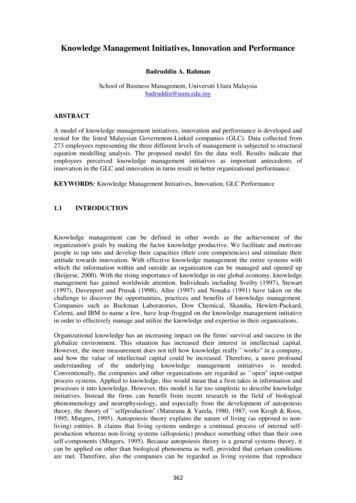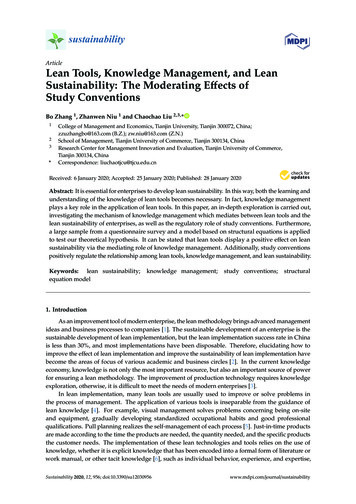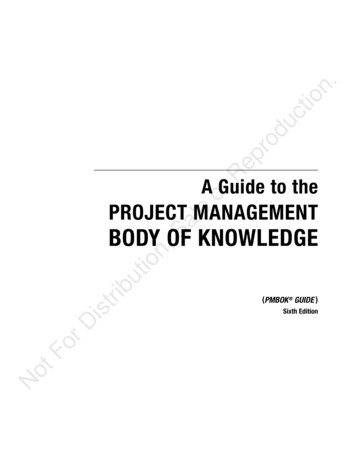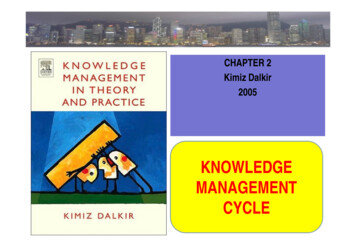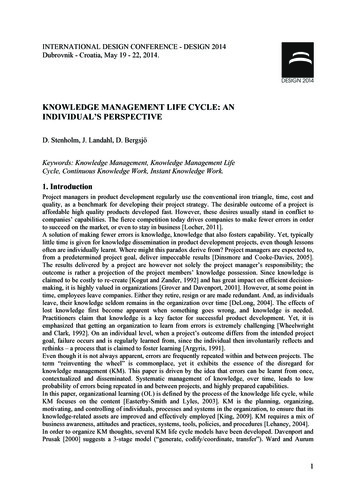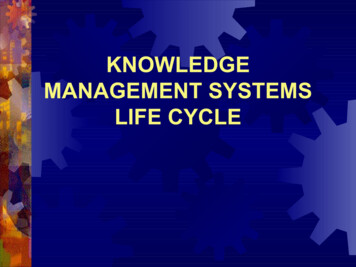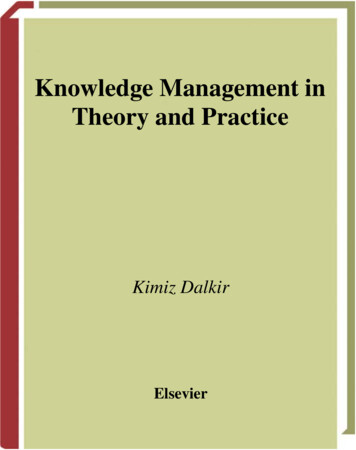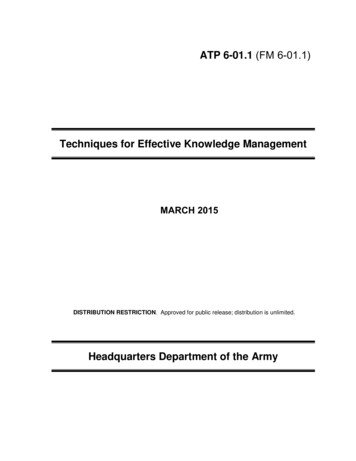
Transcription
ATP 6-01.1 (FM 6-01.1)Techniques for Effective Knowledge ManagementMARCH 2015DISTRIBUTION RESTRICTION. Approved for public release; distribution is unlimited.Headquarters Department of the Army
This publication is available at Army Knowledge .html).To receive publishing updates, please subscribe athttp://www.apd.army.mil/AdminPubs/new subscribe.asp.
*ATP 6-01.1 (FM 6-01.1)HeadquartersDepartment of the ArmyWashington, DC, 6 March 2015ATPNo. 6-01.1Techniques for Effective KnowledgeManagementContentsPagePREFACE. vINTRODUCTION . viChapter 1KNOWLEDGE MANAGEMENT SUPPORT TO THE ARMY . 1-1Knowledge Management . 1-1Enable the Mission Command Warfighting Function . 1-5Organizing the Mission Command System . 1-8Enabling the Operations Process . 1-9Creating a Knowledge-Sharing Environment . 1-11Chapter 2ASSESSING KNOWLEDGE MANAGEMENT . 2-1Assessment . 2-1Knowledge Management Assessment Overview . 2-1Performing the Knowledge Management Assessment . 2-3Assessment Outcome and Recommendations . 2-13Focus Areas for Assessment . 2-14Scenario Illustrating Assessment . 2-14Chapter 3DESIGNING KNOWLEDGE MANAGEMENT SOLUTIONS . 3-1Design Overview . 3-1Solution Design For Common Problem Areas . 3-4Scenario Illustrating Design Solutions . 3-13Chapter 4DEVELOPING KNOWLEDGE MANAGEMENT SOLUTIONS. 4-1Overview . 4-1Developing Solutions . 4-1Scenario Illustrating Solution Development. 4-2Chapter 5PILOTING KNOWLEDGE MANAGEMENT SOLUTIONS . 5-1Piloting Overview . 5-1Knowledge Management Piloting Techniques . 5-1Distribution Restriction: Approved for public release; distribution is unlimited.*This publication supersedes FM 6-01.1, dated 16 July 2012.6 March 2015ATP 6-01.1i
ContentsChapter 6IMPLEMENTING KNOWLEDGE MANAGEMENT SOLUTIONS . 6-1Implementation OvervIew . 6-1Implementation Steps . 6-1Implementation Plan . 6-2Documenting Solutions During Implementation . 6-3Implementation to Assessment . 6-4Appendix AKNOWLEDGE MANAGEMENT ANNEX FORMAT FOR AN OPERATIONS ORDER. A-1Appendix BKNOWLEDGE MANAGEMENT STANDARD OPERATING PROCEDURES. B-1Standard Operating Procedures Development . B-1Appendix CKNOWLEDGE MANAGEMENT TOOLS . C-1Knowledge Management Tools Selection . C-1Non-Digital Knowledge Management Tools . C-1Digital Knowledge Management Tools . C-2Mission Command Information Systems and Collaboration Tools . C-3Appendix DCONTENT MANAGEMENT . D-1Content Management Tasks . D-1Content Management Common Phrases . D-3Content Management Principles . D-3Content Management Techniques . D-5Appendix EINTERVIEWING TECHNIQUES FOR KNOWLEDGE MANAGEMENTASSESSMENTS . E-1Purpose . E-1Role of the Interviewer . E-1Prepare for the Interview . E-2The Interview. E-2Appendix FFACILITATING A PROFESSIONAL FORUM . F-1Army Professional Forums . F-1Appendix GFOCUS AREAS FOR KNOWLEDGE MANAGEMENT ASSESSMENT . G-1Standards Analysis . G-1Time Management . G-1Meeting Analysis . G-2Report Analysis . G-5Technical Systems Analysis . G-5Content Management Analysis . G-6Appendix HKNOWLEDGE MANAGEMENT STRATEGY FORMAT (EXAMPLE) . H-1GLOSSARY . Glossary-1REFERENCES. References-1INDEX . Index-1FiguresFigure 1-1. Knowledge management – an iterative cycle . 1-1iiATP 6-01.16 March 2015
ContentsFigure 1-2. Flattening organizational staff processes . 1-12Figure 2-1. Example of knowledge management priorities chart . 2-9Figure 2-2. Example of a concept map . 2-12Figure 2-3. A way to convey key knowledge management mapping information . 2-13Figure 4-1. Information system interface . 4-13Figure 4-2. Flattening the network . 4-14Figure 4-3. Company Intelligence Support Team (CoIST) collaboration . 4-14Figure 6-1. Knowledge management process cycle . 6-4Figure C-1. Examples of Army professional forums . C-2Figure G-1. Example battle rhythm analysis . G-2TablesTable 1-1. The knowledge management process . 1-2Table 1-2. Inputs and outputs . 1-2Table 1-3. How knowledge management enhances decisionmaking . 1-6Table 2-1. Steps of assess – key inputs and outputs . 2-3Table 2-2. A simple tool for collecting people, processes, tools, and organization data. 2-5Table 2-3. Gap analysis chart. 2-8Table 2-4. Completed gap analysis chart for the initial assessment . 2-17Table 2-5. Completed gap analysis chart for the follow up assessment . 2-19Table 3-1. Steps of design - key inputs and outputs . 3-3Table 3-2. Example meeting agenda quad chart . 3-6Table 3-3. Example significant activities initial report . 3-7Table 3-4. Example of file naming convention (update graphic dates) . 3-10Table 4-1. Steps of develop – key inputs and outputs . 4-2Table 4-2. Balancing the digital and analog components in the brigade combat team. 4-6Table 4-3. Current division reports and proposed changes . 4-15Table 5-1. Pilot steps and key inputs and outputs. 5-2Table 5-2. Assessment measures and variables . 5-3Table 6-1. Implement. 6-2Table 6-2. Gaps to solutions tracker . 6-3Table D-1. Content management table . D-2Table D-2. Content management techniques for individuals . D-5Table D-3. Content management techniques for teams . D-6Table D-4. Content management techniques for organizations . D-6Table E-1. Example interview questions .E-2Table E-2. Things to avoid when interviewing .E-2Table E-3. Tips for a successful interview .E-3Table F-1. Daily tasks . F-3Table F-2. Weekly tasks . F-46 March 2015ATP 6-01.1iii
ContentsTable F-3. Monthly tasks . F-4Table F-4. Quarterly tasks. F-4Table F-5. Performance metrics . F-5Table G-1. Example working group agenda . G-4ivATP 6-01.16 March 2015
PrefacePublication ATP 6-01.1 provides doctrinal knowledge management guidance. It provides doctrine for theorganization and operations of the knowledge management section, and establishes the doctrinal principles,techniques, and procedures necessary to effectively integrate knowledge management into the operations ofbrigades and higher.ATP 6-01.1 applies to knowledge management activities in Army headquarters from brigade through ArmyService component command (“Brigade” includes brigade combat teams (BCT), support brigades, functionalbrigades, and multifunctional brigades).Commanders, staffs, and subordinates ensure their decisions and actions comply with applicable U.S.,international, and, in some cases, host-nation laws and regulations. Commanders at all levels ensure theirSoldiers operate in accordance with the law of war and the rules of engagement. (See Field Manual [FM} 2710).The principal audience for ATP 6-01.1 is all members of the profession of arms. Commanders and staffs ofArmy headquarters serving as joint task force or multinational headquarters should also refer to applicable jointor multinational doctrine concerning the range of military operations and joint or multinational forces. Trainersand educators throughout the Army will also use this manual.ATP 6-01.1 uses joint terms where applicable. Selected joint and Army terms and definitions appear in both theglossary and the text. Terms for which ATP 6-01.1 is the proponent publication (the authority) are marked withan asterisk (*) in the glossary. Definitions for which ATP 6-01.1 is the proponent publication are boldfaced inthe text. For other definitions shown in the text, the term is italicized and the number of the proponentpublication follows the definition.ATP 6-01.1 applies to the Active Army, Army National Guard/Army National Guard of the United States, andUnited States Army Reserve unless otherwise stated.The proponent of ATP 6-01.1 is Headquarters, U.S. Army Training and Doctrine Command. The preparingagencies are the Combined Arms Doctrine Directorate and the Army Operational Knowledge ManagementProponent, both subordinate to the U.S. Army Combined Arms Center. Send written comments andrecommendations on DA Form 2028 (Recommended Changes to Publications and Blank Forms) toCommander, U.S. Army Combined Arms Center and Fort Leavenworth, ATTN: ATZL-MCK-D (ATP org-mailbox@mail.mil; or submit an electronic DA Form 2028.6 March 2015ATP 6-01.1v
This page intentionally left blank.
IntroductionThe Army embraced knowledge management as a discipline in 2003. How the Army manages informationand facilitates the movement of knowledge has changed dramatically in recent years. This includes thegrowth of knowledge management in the Army and refinement of associated technology—both hardwareand software. Recognizing that the ability to efficiently manage knowledge is essential to effective missioncommand, the Army authorized the Army Knowledge Management Qualification Course, with additionalskill identifier to prepare Soldiers for knowledge management’s complex challenges. Knowledgemanagement sections at brigade through theater army headquarters now work with commanders and staffsto help manage knowledge in their organizations; bridging the art of command and the science of controlthrough knowledge management.What individuals and small elements know that could help others cannot be widely shared without themeans to share it. The volume of available information makes it difficult to identify and use relevantinformation. knowledge management provides the means to efficiently share knowledge, thus enablingshared understanding and learning in organizations. To do this, knowledge management creates, organizes,applies, and transfers knowledge and information between authorized people. It seeks to align people,processes, and tools—including information technology—in the organization to continuously capture,maintain, and reuse key information and lessons learned to help units learn and adapt and improve missionperformance. Knowledge management enhances an organization's ability to detect and remove obstacles toknowledge flow, thereby fostering mission success. Because collaboration is a key contributor toknowledge management, it is imperative that everyone be involved in the process: from the generatingforce, that trains and sustains the Soldier, to the Operating Force, which ensures Soldiers survive and thriveevery day in every circumstance or location.The contributions of everyone are important because anyone may be the source of an idea that may becomethe catalyst for a solution that accomplishes missions and saves lives. Though the focus of this document isoperations, knowledge management can be used by organizations and individuals to accomplish manytasks.This publication, and its successors, provides guidance on successfully implementing knowledgemanagement to Soldiers, as well as commanders and staff; in present and future operational environments.ATP 6-01.1 has an introduction, six chapters, and Appendixes A through H. The introduction expands onthe manual’s purpose and summarizes the doctrine it contains. Chapter 1 explains Knowledge managementto support the U. S. Army. Chapter 2 discusses the Knowledge management assessments. Chapter 3discusses designing knowledge management solutions. Chapter 4 discusses developing knowledgemanagement solutions. Chapter 5 discusses piloting knowledge management solutions. Chapter 6 discussesimplementing knowledge management solutions. Appendix A provides a format for a knowledgemanagement annex. Appendix B contains information on knowledge management standard operatingprocedures (SOP). Appendix C discusses knowledge management tools. Appendix D discusses techniquesfor content management. Appendix E discusses interviewing techniques. Appendix F discusses techniquesfor facilitation of a professional forum. Appendix G discusses focus areas for knowledge managementassessments. Appendix H provides a format for a knowledge strategy.6 March 2015ATP 6-01.1vi
This page intentionally left blank.
Chapter 1Knowledge Management Support to the ArmyThis chapter provides an overview on how knowledge management supports theArmy. It begins with a brief overview of knowledge management foundations. Itdescribes how knowledge management enables the mission command warfightingfunction and continues by describing how knowledge management helpscommanders in organizing the mission command system. It then describes howknowledge management enables operations. The chapter concludes by describinghow every element of an organization contributes to a knowledge-sharingorganizational environment.KNOWLEDGE MANAGEMENT1-1. Knowledge management is the process of enabling knowledge flow to enhance shared understanding,learning, and decisionmaking (ADRP 6-0). Knowledge flow is the ease of movement of knowledge inorganizations. Knowledge management uses a five-step process to create shared understanding. The stepsof knowledge management include: Assess. Design. Develop. Pilot. Implement.1-2. Each step of the knowledge management process is described throughout this manual. Figure 1-1shows knowledge management as an iterative cycle.Figure 1-1. Knowledge management – an iterative cycle1-3. Table 1-1 on page 1-2 shows the five steps of the knowledge management
Knowledge management process cycle .6-4 Figure C-1. Examples of Army professional forums. C-2 Figure G-1. . knowledge management, it is imperative that everyone be involved in the process: from the generating force, that trains and sustains the Soldier, to the Opera
